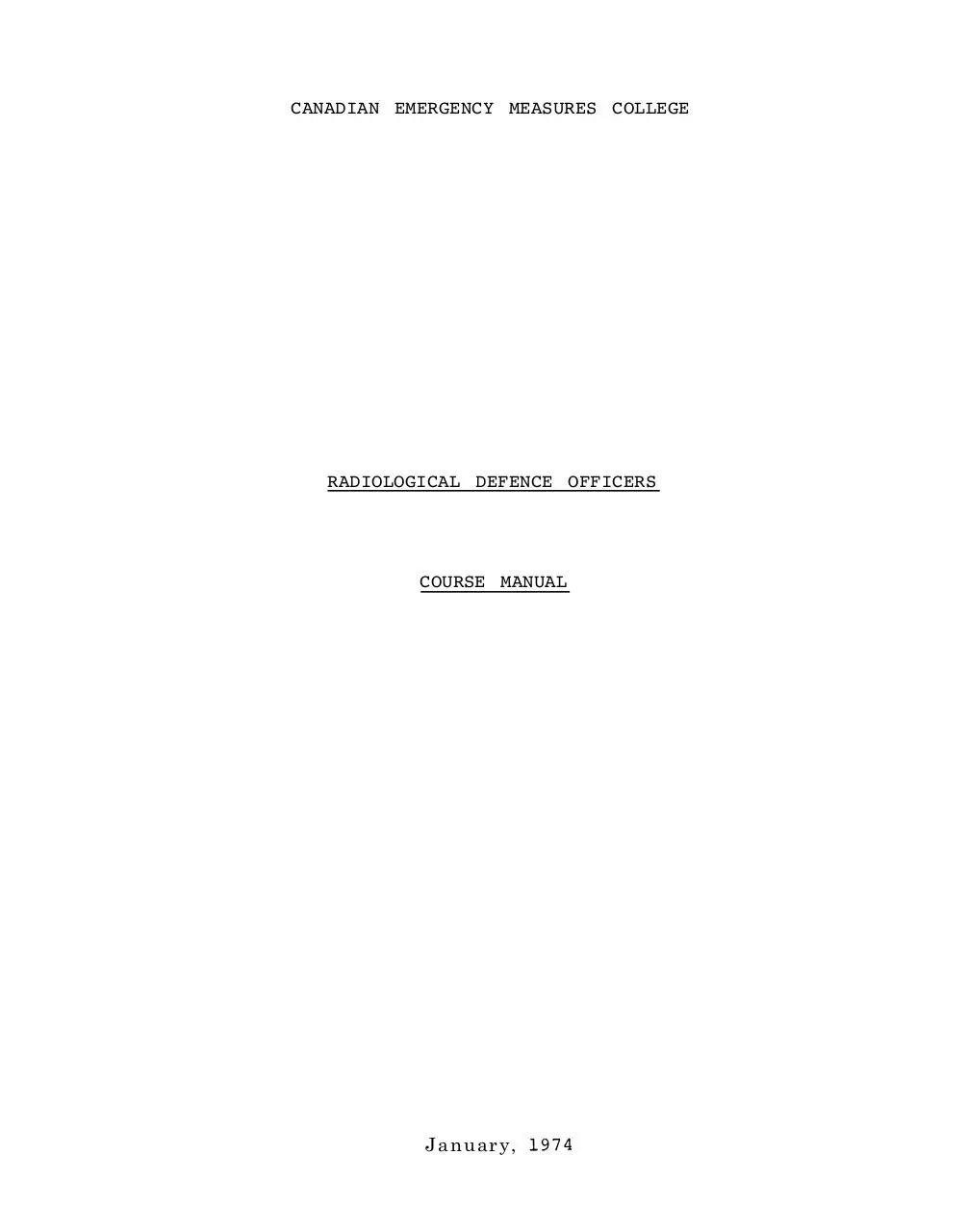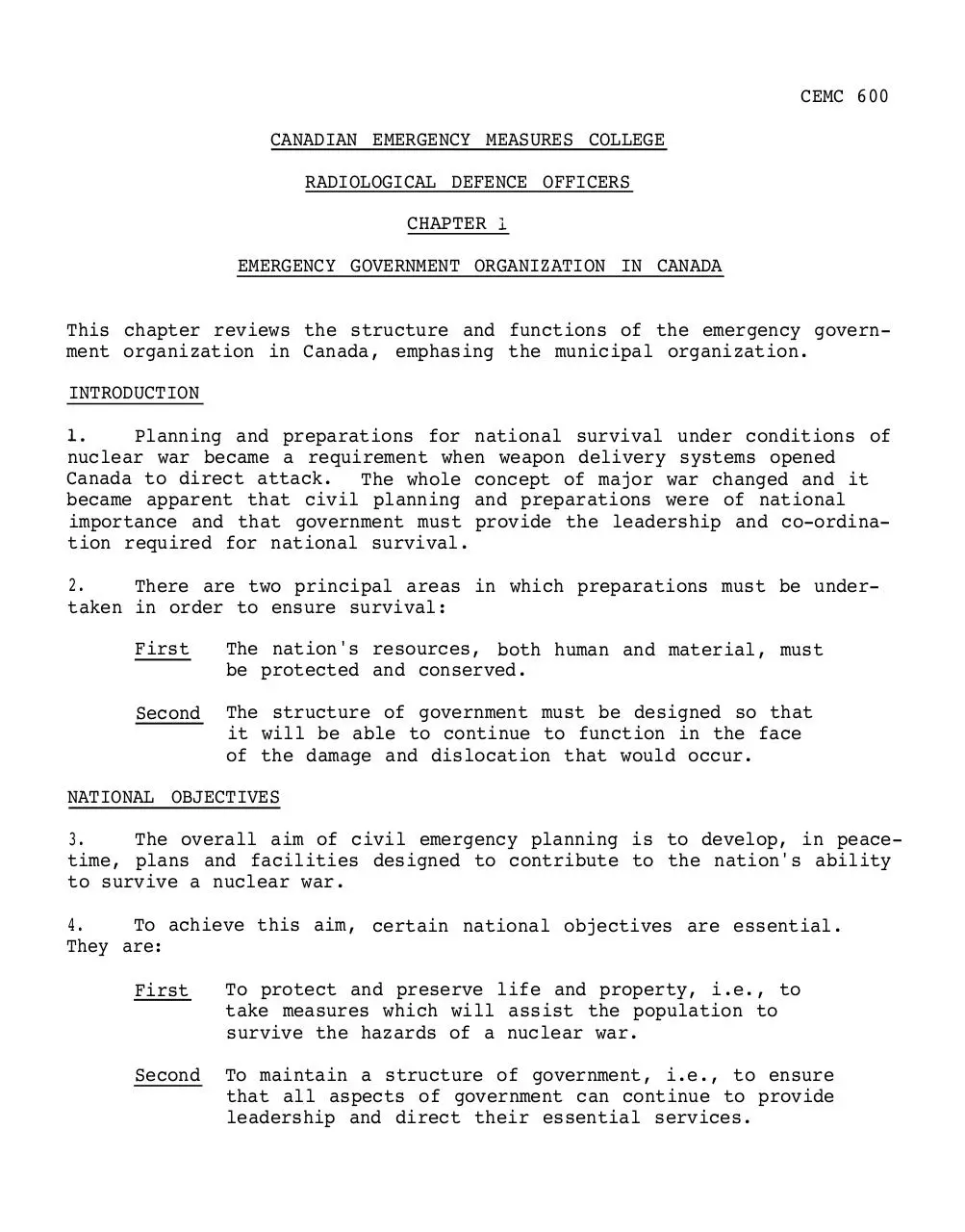Radiological (PDF)
File information
This PDF 1.3 document has been generated by / Mac OS X 10.10.5 Quartz PDFContext, and has been sent on pdf-archive.com on 15/01/2016 at 02:00, from IP address 158.130.x.x.
The current document download page has been viewed 663 times.
File size: 2.05 MB (95 pages).
Privacy: public file





File preview
CANADIAN EMERGENCY MEASURES COLLEGE
RADIOLOGICAL DEFENCE OFFICERS
COURSE MANUAL
January, 1974
CANADIAN EMERGENCY MEASURES COLLEGE
RADIOLOGICAL DEFENCE OFFICERS
TABLE OF CONTENTS
IDENTIFIER
TITLE
600
Chapter 1
Emergency Government Organization
(for self-study)
601
Chapter 2
Radiological Defence
602
Chapter 3
Radiological Effects of Nuclear
Weapons
603
Chapter 4
Fallcut Prediction
604
Chapter 5
Survey Results - Fallout Protection
Survey of Canada
605
Chapter 6
Decontamination (for self-study)
606
Chapter 7
Review of RADEF Analysis
607
Chapter 8
The Dose-rate/Time Graph:
Dose-rate Forecasts
608
Chapter 9
Radiac Calculator (Part 1)
609
Chapter 10
The Dose-rate/Time Graph: Dose
Estimates
610
Chapter $1
Radiac Calculator (Part 2)
611
Chapter 12
Other Methods of Calculation
CEMC 600
CANADIAN EMERGENCY MEASURES COLLEGE
RADIOLOGICAL DEFENCE OFFICERS
CHAPTER 1
EMERGENCY GOVERNMENT ORGANIZATION IN CANADA
This chapter reviews the structure and functions of the emergency government organization in Canada, emphasing the municipal organization.
INTRODUCTION
1.
Planning and preparations for national survival under conditions of
nuclear war became a requirement when weapon delivery systems opened
Canada to direct attack. The whole concept of major war changed and it
became apparent that civil planning and preparations were of national
importance and that government must provide the leadership and co-ordination required for national survival.
2.
There are two principal areas in which preparations must be undertaken in order to ensure survival:
First
The nation's resources, both human and material, must
be protected and conserved.
Second
The structure of government must be designed so that
it will be able to continue to function in the face
of the damage and dislocation that would occur.
NATIONAL OBJECTIVES
The overall aim of civil emergency planning is to develop, in peace3.
time, plans and facilities designed to contribute to the nation's ability
to survive a nuclear war.
4.
To achieve this aim, certain national objectives are essential.
They are:
First
To protect and preserve life and property, i.e., to
take measures which will assist the population to
survive the hazards of a nuclear war.
Second
To maintain a structure of government, i.e., to ensure
that all aspects of government can continue to provide
leadership and direct their essential services.
CEMC 600
-2
Third
-
To conserve resources, i.e., to take measures which,
will ensure that surviving resources are managed
properly in the early post-attack period and therefore,
will help the n-'
aLion to recover in a more rapid and
orderly manner.
The Radiological
5.
the achievement of all
tions are discussed in
second objective:
"TO
Defence (RADEF) organization may be involved in
of these objectives; its specific role and funcsubsequent chapters. This chapter discusses the
maintain a structure of government".
CONCEPT OF EMERGENCY GOVERNMENT
Early planning studies revealed that the degree of damage to
6.
communications, transportation and other facilities could be severe
enough to result in complete or partial disruption of a centrallyoriented government organization. Therefore, it was concluded that the
basic approach to ensuring continuity of government operations in a war
emergency should be decentralization. Decentralization would ensure that
legally constituted civilian authority was in existence, and capable of
providing the necessary direction and control in whatever circumstances
might result from a nuclear attack.
Thus, in 1958 the Government announced the intention to establish
7.
a decentralized system of emergency government. The system would be made
up of central, regional, zonal and municipal elements, with the latter
three having the capability and the delegated authority to act independently should there be a loss of contact with the next higher level in
the chain. There would of course be some limits placed on the degree of
authority delegated to the elements of the structure. For example, the
conduct of overall defence of the nation and international relations remain the prerogative of the central element.
EMERGENCY GOVERNMENT STRUCTURE
The result of the decision to adopt decentralization as a concept
8.
has been the development of an emergency government structure which
would come into existence upon the proclamation of the War Measures Act.
The country has been divided into 10 Emergency Government Regions;
9.
their boundaries coincide with the present provincial boundaries. The
Regions may be further subdivided into Zones. Within each Zone, municipal emergency government elements are formed, each consisting of a
group of urban and rural municipalities.
A line of authority will then extend from the Central element
10.
through Regions and Zones to Municipalities, with each having the power
and authority to control any situation, or resolve problems as they
arise, in accordance with Orders and Regulations prepared under the
authority of the War Measures Act.
CEMC 600
- 3CENTRAL ORGANIZATION
The central emergency government element will be made up of a small
group of federal cabinet ministers and senior departmental officials. The
primary function of this "core" of federal government will be to establish
In order to ensure that they can continue to
and direct national policy.
function, they will operate from a protective facility outside of Ottawa,
referred to as the Central Emergency Government Facility (CEGF).
11.
12.
The policy making core element will require the support of operating
elements of each of the major government departments. The departmental
groups will provide information and technical advice to the policy-makers
and oversee the execution of policy directives. These small groups of
departmental officials will operate from emergency government facilities
referred to as departmental Relocation Units (RUs), in proximity to the
CEGF, and linked by adequate communications.
REGIONAL ORGANIZATION
13.
Within each region a similar group of facilities have been or will
be provided. Regional Emergency Government Headquarters (REGHQ) will provide protection against fallout and will be located where the danger from
direct damage is considered relatively low.
The REGHQ will be staffed by elements of the provincial government,
14.
including the premier, some cabinet ministers, and key departmental
officials, as well as local sections of federal departments including
Canadian Forces personnel. A Regional Commissioner will be appointed as
the senior official. He will receive advice from the provincial and
federal officials and ensure the co-ordination of all operations within
the region. Both the provincial and federal elements in the REGHQ will
be supported by somewhat larger groups at re-location sites similar to
those planned for the central facility.
ZONAL ORGANIZATION
15.
Zone boundaries were determined by consideration of such factors as
population, transportation, existing local or government boundaries, and
communications.
Zone Emergency Government Headquarters (ZEGHQ) are generally located in basements of existing buildings which have been modified to provide fallout protection and austere accommodation for about
70 people. Elements of both federal and provincial governments will be
found in the ZEGHQ.
MUNICIPAL
ORGANIZATION
16.
The base of the emergency government structure is the municipal
level.
The role of a municipal emergency government is somewhat different
to that of the other three echelons. The Central, Regional and Zonal
CEMC 600
- 4echelons will be concerned with overall direction and control of activities within their respective jurisdictions. The Municipal emergency
governments, on the other hand, will be directly involved in the actual
conduct of operations, such as the processing and care of evacuees and
casualties, and in the acquisitiorr of basic intelligence data, such as
measurement of radiation levels and actual observations of damage.
17.
The situation resulting from any nuclear detonation will most
certainly affect many municipalities; communities many miles away may
be subjected to radioactive fallout; operational assistance and support
will also involve many adjacent municipalities. Hence, the grouping of
municipalities in order to pool resources and effect co-ordination of
effort.
Thus the term Municipal Emergency Government encompasses something more than just the immediate geographical area of individual cities,
towns or villages; the term may apply to groups of municipalities, in
which emergency councils are formed. These councils are composed of
representatives of all of the municipal councils involved.
Such an emergency council, in the event of an emergency, would provide the authority
and control for operational activities within the area.
18.
The primary function of a municipal emergency government would be
to direct and control survival operations; its main aim being the restoration and rehabilitation of the community.
MUNICIPAL EMERGENCY GOVERNMENT HEADQUARTERS (MEGHQ)
19.
The Municipal Emergency Government Headquarters organization will
consist of four basic elements:
a.
Executive Control Committee - composed of elected officials,
representative members of the municipal council or councils.
Its composition is such that a legally constituted head of
government is in charge at all times.
b.
Operations and Intelligence - provide the Executive Control
with the information on which decisions can be based and
orders issued, translates these orders into action, and coordinates the activities so generated.
C.
Emergency Services - the heads of the emergency services
and their senior staffs are responsible for provision of
specialized advice, as well as operational control of their
respective emergency services.
d.
Administrative Staff - responsible for meeting the administrative and housekeeping needs of the headquarters.
CEMC 600
-
5-
Two of these elements which are directly concerned with opera20.
tional activities warrant more detailed consideration; particularly
their composition, function, operational responsibilities and methods
of operation. Some of these factors are now discussed.
OPERATIONS AND INTELLIGENCE ELEMENT
21.
The Operations and Intelligence element would probably be headed
by the Emergency Measures planning co-ordinator who, in his capacity as
senior staff officer to the executive, would direct and co-ordinate the
actual conduct of operations.
22.
This element must obtain and analyse information from all pertinent
sources, in order to provide the Executive Control with an accurate and
up-to-date picture of the situation at all times. For this to be accomplished, it will be necessary for relevant data concerning the situation
which applies to each emergency service to be channelled through this
element.
Operations and intelligence will also oversee the execution of
orders and ensure that emergency service heads are kept abreast of any
changes likely to affect their particular tasks.
23.
In effect, this element acts as the hub of the whole organization.
Piecemeal information is fed in, digested and analysed, then passed up
the line in the form of clear and meaningful intelligence reports. Back
down will come decisions and orders, which are then disseminated as
required; the resultant activities are monitored in order to ensure
their fulfilment.
EMERGENCY SERVICES ELEMENT
The various Municipal Emergency Services are the operating elements
24.
of the organization; they will actually carry out orders and conduct
operations.
As previously mentioned, information from them will be essential in the making of decisions and the issuance of orders. Therefore,
representatives of each service, preferably service heads or department
chiefs, will be required on the staff of the Municipal Emergency Government Headquarters.
THE OPERATING SERVICES
25.
The essential functions of those emergency services that are simply
expanded versions of normal municipal departments will not change greatly
in an emergency. There will no doubt be an increase in responsibility
and activity but the prime role of each service will remain essentially
the same.
26.
The following is a list of the emergency services which will likely
be required by most municipalities, though the size of each and its
specific organization will depend upon the size and role of the community.
Download Radiological
Radiological.pdf (PDF, 2.05 MB)
Download PDF
Share this file on social networks
Link to this page
Permanent link
Use the permanent link to the download page to share your document on Facebook, Twitter, LinkedIn, or directly with a contact by e-Mail, Messenger, Whatsapp, Line..
Short link
Use the short link to share your document on Twitter or by text message (SMS)
HTML Code
Copy the following HTML code to share your document on a Website or Blog
QR Code to this page

This file has been shared publicly by a user of PDF Archive.
Document ID: 0000332469.